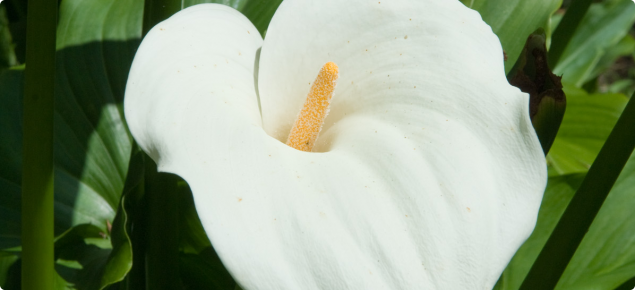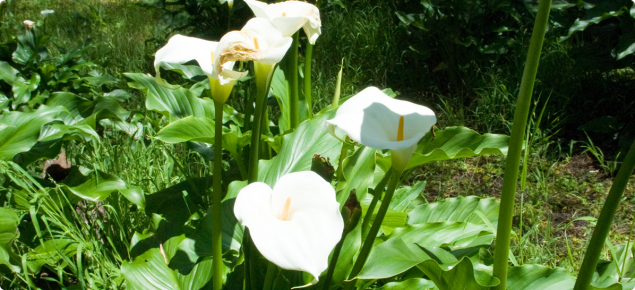Form: herbaceous — perennial
Status: present in WA
Appearance
Arum lily is a robust, dark green, succulent herb, also known as calla or white arum lily. It was introduced to WA from South Africa as a garden plant and subsequently escaped to become established as a weed. It is found in creeks, irrigation ditches and areas of summer-moist land in the higher rainfall south west of WA, often forming large dense clumps.
Arum lily competes with valuable perennial pasture plants on summer land. It has been claimed to cause eczema in humans. Stock deaths have occurred from grazing arum lily.
Arum lily has fleshy roots and forms extensive tubers which store food for future use. The roots when boiled provide a starchy food for some South African tribes, however, they are poisonous when eaten raw.
Arum lily spreads vegetatively by regeneration from tuber fragments and by seeds.
Leaves: the petioles (leaf stalks) are up to 0.4 metres long and smooth; the leaf blades are thick and fleshy, pointed at the apex with blunt lobes at the base.
Flowers: white to greenish white and tubular flowers, becoming funnel shaped at the top with a slit down one side. Flowering takes place in spring.
Fruit: the berry is oval, yellowish, about one centimetre in diameter and contains several round seeds about three millimetres in diameter.
Online weed identification training
Login or set up a new account on DAFWAs online training site to access:
- a training course on how to identify arum lily and report it.
- training material that you can use to teach community groups how to identify arum lily.
Agricultural and economic impact
Toxic to livestock and invades pastures.
Declared pest category
The Western Australian Organism List (WAOL) contains information on the area(s) in which this pest is declared and the control and keeping categories to which it has been assigned in Western Australia (WA). Use the following WAOL link to reach the declaration and declaration map for: arum lily.
Requirements for land owners/occupiers and other persons
Requirements for land owners/occupiers and other persons if this pest is found can be sourced through the declared plant requirements link.
Search > detect > report
Detectability: easy to find. Arum lily is a very conspicuous plant with large leaves and large white flowers. A form with green-and-white flowers is grown as a garden plant and is also a declared plant.
Who is likely to find it: general public, members of biosecurity groups and some community groups (especially those with an interest in wetlands and/or water courses).
When to find it: most noticeable when it flowers, mainly from spring to early summer, though it can flower at other times of the year. Its distinctive large leaves are noticeable a month or two before flowering begins.
Where to find it: in wetlands, along rivers, streams and creeks, seasonally wet areas in low-lying pastures, under trees where birds perch, in dunes and coastal heath, and gardens. Sometimes found on sale at carpark markets and on trading websites.
Report: if plants (not flowers) are being sold or given away to the Pest and Disease Information Service (PaDIS) using the contact details given below.
Control method
Control methods for this declared plant can be found through the arum lily control link.





